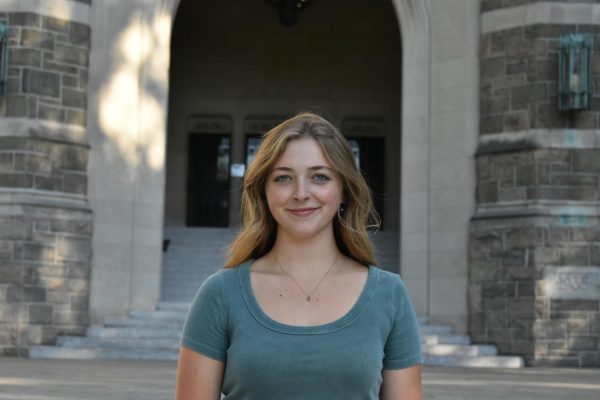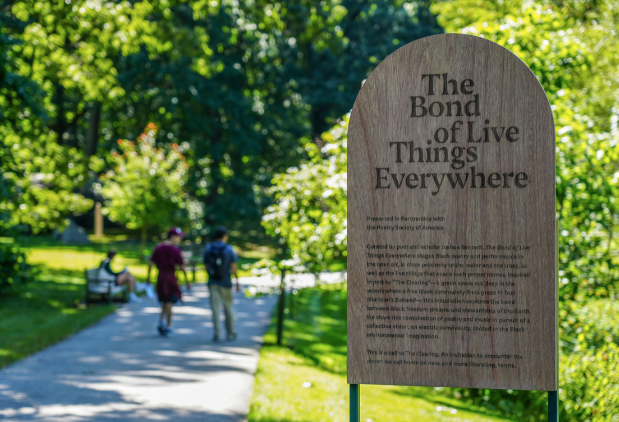The Bond of Poetry and Living Things
Saying goodbye to the painted tables laden with produce, some painted and others woven, the New York Botanical Garden (NYBG) has ushered in a new exhibit for the fall season. Curated by Joshua Bennett, a Bronx-born poet and scholar, and created in partnership with the Poetry Society of America, the exhibit explores Black poetry and performance in the context of nature. “The Bond of Live Things Everywhere” will run from Sept. 17 to Nov. 6, inviting all within that time to reimagine their connection with the environment through poetry.
According to the first of many wooden panels, which greets the visitor at the beginning of the Mitsubishi Wetland trail, Bennett drew his inspiration for the exhibit from “‘The Clearing’ — a green space cut deep in the woods where a free Black community finds grace in Toni Morrison’s ‘Beloved.’” For those unaware, “Beloved” takes place directly after the Civil War and follows the story of Sethe, a formerly enslaved woman who believes the malevolent spirit haunting her family belongs to the child she killed to spare them from slavery. In the story, “The Clearing” serves as a space for the freed, Black community to comfort one another and overcome the horrors within their memories. Bennett’s hope with this exhibit is to call people to “The Clearing,” inviting them “to encounter the planet we call home on new, and more liberating, terms.”
The exhibit wholly surrounds the visitor, wrapping them in an immersive blanket woven from sound, sight and touch. It’s hard to tell where the exhibit ends and the typical atmosphere of the Mitsubishi Wetland begins. As audio of poems being read aloud blares from speakers, birds call to one another about food, territory, perhaps even the poetry. The cattails gone to seed and the overgrown, summer foliage of the wetland shrubbery highlight the dark words carved onto the wooden panels that stood along the walk. Even the feel of the engraved words, which Bennett begs his audience to touch, is changed by the wayward bug wandering along or the moisture beading along the panels. In this exhibit, art steps into nature. As nature then shapes the exhibit, the two become inextricably intertwined.
“I wanted to capture that ancient interest in the earth and turn it into an installation that people could travel to and travel through. That they could experience not just in terms of sights, but sounds, signs made of wood that they could feel with the poems engraved in them,” said Bennett for the NYBG’s “Plant Talk.”
The poems are the primary focus of the exhibit and feature highlights from the work of eleven Black poets, such as Lucille Clifton, Claude McKay and Terrance Hayes. Their poems describe the relationships people have with the environment, their food and liberation. The name of the exhibit even comes from the final line of Clifton’s poem, “cutting greens,” which relates the act of cutting vegetables with physical intimacy, exploring the ways in which the boundaries between the body, the mind and the natural world become blurred.
Throughout the exhibit, Bennett explores this muddied space between art, nature and humanity, as he embeds themes of breaking down structures and reconnecting with the environment into the very execution of the exhibit itself. Besides the poems that blur time and space, joining McKay’s memory of the Harlem Renaissance to Haye’s contemporary writing, the infusion of audio further evolves the exhibit. Working alongside Marcus Johnson, a creative director of music composition and multimedia, Bennett brought the poems to life. While reading one poem, a deep voice begins to roll through another or a choir begins to sing a song. Mixing with the sound of tree leaves rustling or birds chatting with one another, the words of the poems do not merely fall flat upon the page but whisper around the visitor.
“Tell me there is anything lovelier, / Anything more quieting / Than the green of little blades of grass / And the green of little leaves?” asks Angelina Weld Grimké’s poem, “Greeness,” one of the selected twelve. How can I, upon reading that poem in such a setting, argue with Grimké? Immersed in the sight, smell and rustle of green, there truly is nothing lovelier. There lies the magic of Bennett’s exhibit, as his combination of all these varying elements intoxicate his visitor.
Furthering the themes of liberation and reimagining people’s relationship with the environment, the NYBG has also planned lots of events that complement the exhibit. On opening day, the NYBG hosted a celebration that consisted of music, poetry readings, books, food, games and a symposium “meditating on the role of Black ecological thought from the panelists’ own work and life.” Although the opening celebration took place on Sept. 17, the closing celebration on Nov. 6 will have many similar events including picnicking, music and live poetry readings.
If you have not yet had the pleasure, I urge you to visit NYBG’s new exhibit. The Mitsubishi Wetland Trail is one of my favorite spots to visit in the gardens as it’s so rich with life, and the poetry woven into the environment only exemplifies that.

Kari White is a senior from the blink-and-you’ll-miss-it state of Delaware. She is majoring in English with a concentration in creative writing, as well...








































































































































































































